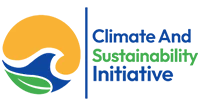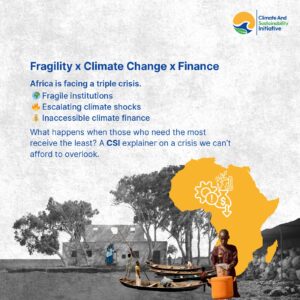Africa is home to over 1.5 billion people across 54 countries (IMF, 2025) and has a GDP of roughly USD 2.8 trillion (IMF, 2025). Nonetheless, it remains disproportionately affected by poverty. In 2019, an estimated 35 per cent of the Sub-Saharan African population lived in extreme poverty, compared to 9 per cent in South Asia and a mere 1 per cent in East Asia and the Pacific (Baah & Lakner, 2023). As of 2022, 38 per cent of the entire African population lived in extreme poverty (Sinha, Inchauste, & Narayan, 2024). This sweeping prevalence of poverty in Africa, however, does not solely stem from economic factors. Institutional, social, and political fragility play an equally critical role.
Fragility is both a cause and a consequence of poverty. According to the World Fragility Index, 19 of the world’s 35 most fragile countries are in Africa (FSI, 2024). According to the World Bank, 23 of the 39 most conflict-affected and institutionally weak countries are located on the African continent (World Bank, 2024). Fragility refers to systemic breakdowns in institutional capacity and governance, which render the state incapable of functioning effectively. It is a multidimensional condition that fuels political violence, food insecurity, and forced displacement in many cases (UNDP, n. d.).
Between June and August 2023, food insecurity affected an estimated 10.2 million individuals across Burkina Faso, Chad, Mali, Mauritania, and Niger. Among them, over 900,000 were in emergency conditions, with famine-like conditions impacting more than 45,000 people in Burkina Faso and Mali. In the Horn of Africa, around 36 million people were experiencing acute food insecurity as Ethiopia, Kenya, and Somalia endured their most severe drought in four decades. Meanwhile, following Cyclone Freddy in 2023, staple food prices, such as maize, increased by up to 300% in Malawi and Mozambique, worsening food and nutritional insecurity (World Bank Group, 2024). The intersection of these stressors with climate change can compound the crisis. Climate change is not simply an environmental threat; it exacerbates pre-existing fragilities by creating a feedback loop: environmental degradation can worsen instability, and unstable governance weakens climate action.
Recent events further demonstrate how this crisis is compounding. Between late January and mid-March 2024, Southern Africa experienced a severe dry spell. Rainfall levels fell to just half of what was expected, resulting in lower crop yields (Harrison et al., 2024). In response, Zambia, Malawi, and Zimbabwe declared it a national disaster (NASA EO, 2024). Meanwhile, in Africa’s tropical belt, 27 countries saw catastrophic flooding that displaced over 4 million people and took more than 2,500 lives (ACSS, 2024). Healthcare facilities were destroyed, the number of cholera and malaria cases rose sharply, and over 10 million children lost access to education due to infrastructural damage (ACSS, 2024; Mutsaka, 2024).
Despite growing evidence that climate change in fragile, conflict-affected, and violent (FCV) countries undermines peacebuilding and development, global inaction continues. In 2021, 23 per cent of the total climate-related development finance reached fragile states, while highly fragile countries received only 6 per cent – indicating risk-averse financing (Meijer & Ahmad, 2024). The UNDP has also emphasised the peace–climate–security nexus, warning that climate change can inflame local grievances and destabilise fragile peace settlements (UNDP, 2020). Even when funds are directed to conflict-affected areas, they often skip the most fragile regions. This phenomenon, known as the “streetlight effect”, occurs when donors focus on areas that are easier to reach and measure, rather than those in urgent need. The Global Environment Facility (GEF) and the Green Climate Fund have attempted to reach fragile zones, with 33 per cent of GEF’s initiatives targeting moderately to severely violent regions (Raleigh et al., 2024). However, within these countries, funding still tends to gravitate towards low-risk zones (Raleigh et al., 2024). In parallel, an analysis of Organisation for Economic Co-operation and Development (OECD) adaptation finance from 2014 to 2018 shows that while 45–50 per cent of funds went to FCV countries, they bypassed the epicentres of violence (Naran et al, 2024). The Climate Policy Initiative (CPI) affirms that international climate finance to Africa remains highly concentrated, with the top ten recipient countries receiving 46 per cent of the total financing (Meattle, 2024). In contrast, the ten African countries most vulnerable to the impacts of climate change receive just 11 per cent of the funding (Meattle, 2024). Thus, the streetlight effect is guided by a circular logic: risk aversion reinforces the exclusion of FCV countries, even when their vulnerability is the highest.
International finance is not only essential but also indispensable for FCV countries, as their disrupted economic activity limits private investment, damages or renders their infrastructure vulnerable, and limits their tax collection capacity due to institutional weakness. Simultaneously, recurrent climate shocks such as droughts, floods, and desertification adversely impact agricultural productivity, leading to food insecurity. This leaves nation-states unable to finance even the basic needs of their populations, let alone spend on climate adaptation or mitigation efforts. External support is, therefore, foundational. For example, the Central African Republic (CAR) needs over USD 1.7 billion to realise its 2021–2030 climate goals, as mentioned in its latest Nationally Determined Contributions (NDC) report (MoESD, 2021). However, 84 per cent of the total amount is expected to flow from international donors (MoESD, 2021). A similar pattern can be observed in the NDC reports of Niger and Somalia, which rely on international donor finance for 73 per cent and 87 per cent of their climate funding, respectively (RoN, 2021; FRS, 2021). A cross-analysis of the net official development assistance (ODA) as a percentage of the gross capital formation (GCF) further illustrates the extent of aid reliance: Somalia’s net ODA forms 80 to 220 per cent of its GCF; CAR’s ODA constitutes 96 to 137 per cent of its GCF; and Chad and Niger’s ODAs make up 19 to 49 per cent of their capital formation, respectively (World Bank, n.d.). The structural aid dependency evident here is symptomatic of countries stuck in a loop of fragility, underinvestment, and external reliance.
In FCV settings, the line between humanitarian and climate crisis becomes increasingly blurred. Ignoring their intersection reinforces a status quo where those least responsible for climate change bear the highest burden of its impacts, without the institutional or financial means to respond. The challenge, however, extends beyond the volume of climate finance required to the design of its delivery. Current financing mechanisms depend on the presence of stable institutions and absorption capacity, conditions rarely guaranteed in an FCV country.
Aid architecture needs to be recalibrated to make it conflict-sensitive and structurally adaptive. Delivery designs should be adapted to operate in low-governance environments without reinforcing parallel systems, which weaken the government’s legitimacy. Women, youth, and Indigenous communities must participate actively, as beneficiaries and co-designers. In FCV countries, climate finance can only move from transactional disbursements to developmental outcomes by simultaneously addressing climate vulnerability and fragility and by acknowledging their interdependence.
By Asmi Manudhane, Research Assistant at Climate and Sustainability Initiative. Views expressed are personal.
References
Africa Center for Strategic Studies (ACSS). (2024) Record levels of flooding in Africa compounds stress on fragile countries. https://africacenter.org/spotlight/record-levels-of-flooding-in-africa-compounds-stress-on-fragile-countries/
Baah, S. K. T., & Lakner, C. (2023). Fragility and poverty in Sub‑Saharan Africa: Two sides of the same coin. World Bank Blogs. https://blogs.worldbank.org/en/opendata/fragility-and-poverty-sub-saharan-africa-two-sides-same-coin
Fragile States Index. (2024). Global data. https://fragilestatesindex.org/global-data/
Harrison, L., Funk, C., Turner, W., Magadzire, A.H., Peterson, P., Shukla, S., Mogane, P., & Husak, G. (2024). Southern Africa hit with driest February on record in central areas. Climate Hazards Center, University of California, Santa Barbara. https://blog.chc.ucsb.edu/?p=1375
International Monetary Fund (IMF). (2025). AFQ regional profile – World Economic Outlook Datamapper. https://www.imf.org/external/datamapper/profile/AFQ
Independent Evaluation Group (IEG). (2025). An evaluation of the World Bank Group strategy for fragility, conflict, and violence 2020–25. https://ieg.worldbankgroup.org/sites/default/files/Data/reports/ap_FCV.pdf
Meattle, C., Balm, A., Diaz, J.E., Miao, G., Stout, S., Gupta, I., Abraham, S., Sloley, A., & Wignarajah, D. (2024). Landscape of climate finance in Africa 2024. Climate Policy Initiative. https://www.climatepolicyinitiative.org/publication/landscape-of-climate-finance-in-africa-2024/
Meijer, K., & Ahmad, A.S. (2024). Unveiling challenges and gaps in climate finance in conflict areas. SIPRI Insights on Peace and Security, 2024(3): 1–20. https://www.sipri.org/sites/default/files/2024-10/2024_03_climate_finance_in_conflict_areas_0.pdf
Ministry of Environment and Sustainable Development, Central African Republic. (2021). Nationally Determined Contribution (NDC) Revised Version. https://unfccc.int/sites/default/files/NDC/2022-06/CDN%20Revis%C3%A9e%20RCA.pdf
Mutsaka, F. (2024, February 29). Fresh from a deadly cholera outbreak, Zambia declares drought a national emergency. The Associated Press. https://apnews.com/article/drought-national-disaster-emergency-electricity-4cc6a2105f4641efe17e10a5b75f78a5
Naran, B., Buchner, B., Price, M., Stout, S., Taylor, M., & Zabeida, D. (2024). Global landscape of climate finance 2024: Insights for COP29. Climate Policy Initiative. https://www.climatepolicyinitiative.org/wp-content/uploads/2024/10/Global-Landscape-of-Climate-Finance-2024.pdf
NASA Earth Observatory. (2024). Severe drought in Southern Africa. https://earthobservatory.nasa.gov/images/152711/severe-drought-in-southern-africa
Raleigh, C., Linke, A., Barrett, S., & Kazemi, E. (2024). Climate finance and conflict: Adaptation amid instability. Lancet Planet Health, 8(1): e51–e60.
Republic of Niger. (2021). Nationally determined contribution. https://unfccc.int/sites/default/files/NDC/2022-06/CDN_Niger_Révisée_2021.pdf
Sinha, N., Inchauste, G., & Narayan, A. (2024). Leveling the playing field: Addressing structural inequalities to accelerate poverty reduction in Africa. World Bank.
The Federal Republic of Somalia. (2021). Updated nationally determined contribution (NDC). https://unfccc.int/sites/default/files/NDC/2022-06/Final%20Updated%20NDC%20for%20Somalia%202021.pdf
United Nations Development Programme (UNDP). (2020). The climate security nexus and the prevention of violent extremism: Working at the intersection of major development challenges. https://www.undp.org/publications/undp-climate-security-nexus-and-prevention-violent-extremism
UNDP. (n.d.). Breaking the cycle of fragility. https://www.undp.org/crisis/breaking-cycle-fragility.
United Nations Human Rights Council (UNHRC). (2023). UNHRC’s Grandi: 110 million displaced is an indictment on our world. https://www.unhcr.org/news/stories/unhcr-s-grandi-110-million-displaced-indictment-our-world
World Bank. (2025). Classification of fragile and conflict-affected situations: FY25 list of fragile and conflict-affected situations. World Bank. https://thedocs.worldbank.org/en/doc/b3c737c4687db176ec98f5c434d0de91-0090082024/original/FCSListFY25.pdf
World Bank. (n.d.). Economic policy & debt: Official development assistance. World Bank DataBank. https://databank.worldbank.org/reports.aspx?source=2&series=DT.ODA.ODAT.GI.ZS&country=
World Bank. (2024). Enhancing Food and Nutrition Security in the Sahel and Horn of Africa. World Bank Group. https://www.worldbank.org/en/results/2024/01/04/enhancing-food-and-nutrition-security-in-the-sahel-and-horn-of-afe-africa


